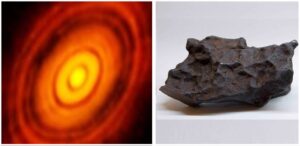Solar System Formed Like a Donut Not a Ring: Shocking Discovery!
Meteorites reveal our solar system wasn’t a flat disc when it formed, but a doughnut! This ring-shaped birth explains how precious metals reached the outer planets, defying previous understanding.
CONTENTS: Solar System Formed Like a Donut Not a Ring

Meteorites hold solar system history
Solar System Formed Like a Donut Not a Ring
Approximately four billion years ago, our solar system emerged from a swirling cloud of gas and dust around the sun. Scientists have been curious about the structure of this early planetary disk, which acted as a cradle for our solar system. While astronomers study distant protoplanetary disks, which vary widely in appearance, understanding the precise configuration of our own has been challenging. However, recent research suggests that meteorites could provide valuable insights into the ancient history of our solar system.
Doughnut-shaped solar system origin
In a recent study published in the Proceedings of the National Academy of Sciences, planetary scientists from UCLA and Johns Hopkins University Applied Physics Laboratory proposed that meteorites from the early solar system contain clues about its formation. The researchers highlighted that refractory metals found in these meteorites, such as platinum and iridium, could shed light on the structure of our early solar system.
According to the study, these metals tend to condense at high temperatures. Interestingly, they were more prevalent in meteorites originating from the outer disk of the solar system, which was colder due to its greater distance from the sun. This distribution suggests a process by which these metals, typically formed closer to the sun, were transported outward.
Contrary to previous beliefs about its structure, the study suggests that our early solar system did not initially resemble a ring but rather had a more doughnut-like shape. As the solar system rapidly expanded, asteroids containing metal grains rich in platinum and iridium migrated to the outer regions of this expanding disk.
Refractory metals defied gravity
Previous research utilizing the Atacama Large Millimeter/submillimeter Array in Chile indicated that our protoplanetary disk had a structure resembling concentric rings, akin to a dartboard. This observation was consistent with the discovery of similar ring-like structures around other stars.
These concentric rings posed a barrier preventing refractory metals from the inner disk from reaching the outer disk because of the gaps between them. However, through computer simulations, the research team determined that an initial doughnut-shaped structure could facilitate the migration of these metals to the outer regions during the disk’s expansion phase.
A lingering question arose: after the expansion of the disk, why didn’t gravitational forces draw these metals back toward the sun?
Check out TimesWordle.com for all the latest news
You must be logged in to post a comment.